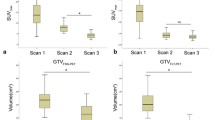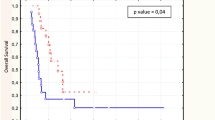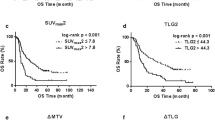Abstract
Purpose
The aim of this study was to determine whether 18F-fluorothymidine (FLT) PET is feasible for the early prediction of tumor response to induction chemotherapy followed by concurrent chemoradiotherapy in patients with esophageal cancer.
Methods
This study was prospectively performed as a collateral study of “randomized phase II study of preoperative concurrent chemoradiotherapy with or without induction chemotherapy with S-1/oxaliplatin in patients with resectable esophageal cancer”. 18F-FLT positron emission tomography (PET) images were obtained before and after two cycles of induction chemotherapy, and the percent change of maximum standardized uptake value (SUVmax) was calculated. All patients underwent esophagography, gastrofiberoscopy, endoscopic ultrasonography (EUS), computed tomography (CT) and 18F-fluorodeoxyglucose (FDG) PET at baseline and 3–4 weeks after completion of concurrent chemoradiotherapy. Final tumor response was determined by both clinical and pathologic tumor responses after surgery.
Results
The 13 patients for induction chemotherapy group were enrolled until interim analysis. In a primary tumor visual analysis, the tumor detection rates of baseline 18F-FLT and 18F-FDG PET were 85% and 100%, respectively. The tumor uptakes on 18F-FLT PET were lower than those of 18F-FDG PET. Among nine patients who completed second 18F-FLT PET, eight patients were responders and one patient was a non-responder in the assessment of final tumor response. The percent change of SUVmax in responders ranged from 41.2% to 79.2% (median 57.1%), whereas it was 10.2% in one non-responder.
Conclusion
The percent change of tumor uptake in 18F-FLT PET after induction chemotherapy might be feasible for early prediction of tumor response after induction chemotherapy and concurrent chemoradiotherapy in patients with esophageal cancer.



Similar content being viewed by others
References
Westerterp M, van Westreenen HL, Reitsma JB, Hoekstra OS, Stoker J, Fockens P, et al. Esophageal cancer: CT, endoscopic US, and FDG PET for assessment of response to neoadjuvant therapy—systematic review. Radiology. 2005;236:841–51.
Malaisrie SC, Hofstetter WL, Correa AM, Ajani JA, Komaki RR, Rice DC, et al. The addition of induction chemotherapy to preoperative, concurrent chemoradiotherapy improves tumor response in patients with esophageal adenocarcinoma. Cancer. 2006;107:967–74.
Gebski V, Burmeister B, Smithers BM, Foo K, Zalcberg J, Simes J. Survival benefits from neoadjuvant chemoradiotherapy or chemotherapy in oesophageal carcinoma: a meta-analysis. Lancet Oncol. 2007;8:226–34.
Flanagan FL, Dehdashti F, Siegel BA, Trask DD, Sundaresan SR, Patterson GA, et al. Staging of esophageal cancer with 18F-fluorodeoxyglucose positron emission tomography. AJR Am J Roentgenol. 1997;168:417–24.
Weber WA, Ott K, Becker K, Dittler HJ, Helmberger H, Avril NE, et al. Prediction of response to preoperative chemotherapy in adenocarcinomas of the esophagogastric junction by metabolic imaging. J Clin Oncol. 2001;19:3058–65.
Ott K, Weber WA, Lordick F, Becker K, Busch R, Herrmann K, et al. Metabolic imaging predicts response, survival, and recurrence in adenocarcinomas of the esophagogastric junction. J Clin Oncol. 2006;24:4692–8.
Kubota R, Yamada S, Kubota K, Ishiwata K, Tamahashi N. Ido T Intratumoral distribution of fluorine-18-fluorodeoxyglucose in vivo: high accumulation in macrophages and granulation tissues studied by microautoradiography. J Nucl Med. 1992;33:1972–80.
Haberkorn U, Strauss LG, Dimitrakopoulou A, Engenhart R, Oberdorfer F, Ostertag H, et al. PET studies of fluorodeoxyglucose metabolism in patients with recurrent colorectal tumors receiving radiotherapy. J Nucl Med. 1991;32:1485–90.
Shields AF, Grierson JR, Dohmen BM, Machulla HJ, Stayanoff JC, Lawhorn-Crews JM, et al. Imaging proliferation in vivo with [F-18]FLT and positron emission tomography. Nat Med. 1998;4:1334–6.
Buck AK, Halter G, Schirrmeister H, Kotzerke J, Wurziger I, Glatting G, et al. Imaging proliferation in lung tumors with PET: 18F-FLT versus 18F-FDG. J Nucl Med. 2003;44:1426–31.
Chen W, Cloughesy T, Kamdar N, Satyamurthy N, Bergsneider M, Liau L, et al. Imaging proliferation in brain tumors with 18F-FLT PET: comparison with 18F-FDG. J Nucl Med. 2005;46:945–52.
Chao KS. Functional imaging for early prediction of response to chemoradiotherapy: 3′-deoxy-3′-18F-fluorothymidine positron emission tomography—a clinical application model of esophageal cancer. Semin Oncol. 2006;33:S59–63.
Edge SB. Compton CC The American Joint Committee on Cancer: the 7th edition of the AJCC cancer staging manual and the future of TNM. Ann Surg Oncol. 2010;17:1471–4.
Lee SJ, Oh SJ, Chi DY, Kil HS, Kim EN, Ryu JS, et al. Simple and highly efficient synthesis of 3′-deoxy-3′-[18F]fluorothymidine using nucleophilic fluorination catalyzed by protic solvent. Eur J Nucl Med Mol Imaging. 2007;34:1406–9.
Lordick F, Ott K, Krause BJ. New trends for staging and therapy for localized gastroesophageal cancer: the role of PET. Ann Oncol. 2010;21 Suppl 7:vii294–9.
Klaeser B, Nitzsche E, Schuller JC, Koberle D, Widmer L, Balmer-Majno S, et al. Limited predictive value of FDG-PET for response assessment in the preoperative treatment of esophageal cancer: results of a prospective multi-center trial (SAKK 75/02). Onkologie. 2009;32:724–30.
Shreve PD, Anzai Y, Wahl RL. Pitfalls in oncologic diagnosis with FDG PET imaging: physiologic and benign variants. Radiographics. 1999;19:61–77. quiz 150–151.
Leyton J, Latigo JR, Perumal M, Dhaliwal H, He Q. Aboagye EO Early detection of tumor response to chemotherapy by 3′-deoxy-3′-[18F]fluorothymidine positron emission tomography: the effect of cisplatin on a fibrosarcoma tumor model in vivo. Cancer Res. 2005;65:4202–10.
Ullrich RT, Zander T, Neumaier B, Koker M, Shimamura T, Waerzeggers Y, et al. Early detection of erlotinib treatment response in NSCLC by 3′-deoxy-3′-[18F]-fluoro-L-thymidine ([18F]FLT) positron emission tomography (PET). PLoS One. 2008;3:e3908.
Pio BS, Park CK, Pietras R, Hsueh WA, Satyamurthy N, Pegram MD, et al. Usefulness of 3′-[F-18]fluoro-3′-deoxythymidine with positron emission tomography in predicting breast cancer response to therapy. Mol Imaging Biol. 2006;8:36–42.
Kenny L, Coombes RC, Vigushin DM, Al-Nahhas A, Shousha S. Aboagye EO Imaging early changes in proliferation at 1 week post chemotherapy: a pilot study in breast cancer patients with 3′-deoxy-3′-[18F]fluorothymidine positron emission tomography. Eur J Nucl Med Mol Imaging. 2007;34:1339–47.
Chen W, Delaloye S, Silverman DH, Geist C, Czernin J, Sayre J, et al. Predicting treatment response of malignant gliomas to bevacizumab and irinotecan by imaging proliferation with [18F]fluorothymidine positron emission tomography: a pilot study. J Clin Oncol. 2007;25:4714–21.
Yue J, Chen L, Cabrera AR, Sun X, Zhao S, Zheng F, et al. Measuring tumor cell proliferation with 18F-FLT PET during radiotherapy of esophageal squamous cell carcinoma: a pilot clinical study. J Nucl Med. 2010;51:528–34.
Wieder HA, Geinitz H, Rosenberg R, Lordick F, Becker K, Stahl A, et al. PET imaging with [18F]3′-deoxy-3′-fluorothymidine for prediction of response to neoadjuvant treatment in patients with rectal cancer. Eur J Nucl Med Mol Imaging. 2007;34:878–83.
Herrmann K, Wieder HA, Buck AK, Schoffel M, Krause BJ, Fend F, et al. Early response assessment using 3′-deoxy-3′-[18F]fluorothymidine-positron emission tomography in high-grade non-Hodgkin’s lymphoma. Clin Cancer Res. 2007;13:3552–8.
van Westreenen HL, Cobben DC, Jager PL, van Dullemen HM, Wesseling J, Elsinga PH, et al. Comparison of 18F-FLT PET and 18F-FDG PET in esophageal cancer. J Nucl Med. 2005;46:400–4.
Francis DL, Visvikis D, Costa DC, Arulampalam TH, Townsend C, Luthra SK, et al. Potential impact of [18F]3′-deoxy-3′-fluorothymidine versus [18F]fluoro-2-deoxy-D-glucose in positron emission tomography for colorectal cancer. Eur J Nucl Med Mol Imaging. 2003;30:988–94.
Yamamoto Y, Nishiyama Y, Kimura N, Ishikawa S, Okuda M, Bandoh S, et al. Comparison of 18F-FLT PET and 18F-FDG PET for preoperative staging in non-small cell lung cancer. Eur J Nucl Med Mol Imaging. 2008;35:236–45.
Acknowledgements
This work was supported by Real-time Molecular Imaging Program from National Research Foundation (NRF), through its real-time molecular imaging research program (no. 2010–002040).
Conflicts of Interest
None.
Author information
Authors and Affiliations
Corresponding author
Rights and permissions
About this article
Cite this article
Park, S.H., Ryu, JS., Oh, SJ. et al. The Feasibility of 18F-Fluorothymidine PET for Prediction of Tumor Response after Induction Chemotherapy Followed by Chemoradiotherapy with S-1/Oxaliplatin in Patients with Resectable Esophageal Cancer. Nucl Med Mol Imaging 46, 57–64 (2012). https://doi.org/10.1007/s13139-011-0118-4
Received:
Revised:
Accepted:
Published:
Issue Date:
DOI: https://doi.org/10.1007/s13139-011-0118-4




